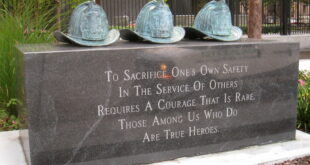
Flashpoint
May 27 Webinar on Water Supply–Help Overturn Proposed Language that Could Hurt Sprinkler Contractors
The topic of this month’s column is simple and short. Your attention and assistance are needed on an issue occurring with the development of the 2022 edition of NFPA 13, Standard for the Installation of Sprinkler Systems. The 2022 edition is almost finalized. Using a football analogy, we are in the fourth quarter with less than two minutes on the clock. We are down to our final push to score to win the game.
The AFSA technical staff, with the full support of the Board of Directors, is requesting all members and friends assist “us” in overturning new language, which has been accepted in the 2022 edition of NFPA 13. This new proposed language is as follows: (All bold red text is added new language)
4.5 Water Supply Information.
4.5.1 Water Supply Capacity Information.
The following information shall be included:
1. Location and elevation of static and residual test gauge and flow hydrant(s) with relation to the riser reference point
2. Flow location
3. Static pressure, psi (bar)
4. Residual pressure, psi (bar)
5. Flow, gpm (L/min)
6. Date
7. Time
8. Name of person who conducted the test or supplied the information
9. Other sources of water supply, with pressure or elevation
4.5.1.2 Where a waterflow test is used for the purposes of system design, the test shall be conducted no more than 12 months prior to working plan submittal unless otherwise approved by the authority having jurisdiction.
A.4.5.1.2 Alternative means of determining available water supplies should be considered where drought or other concerns are present.
5.2.2.2.2.1* The evaluation shall be based on knowledge of the water supply and engineering judgment and shall consider daily and seasonal fluctuations, not extreme conditions.
A.5.2.2.2.2.1 The evaluation to determine whether an adjustment should be made and the size of such an adjustment should consider the following variables, applicable to different degrees depending on how and when the test was conducted:
1. Maximum daily use of the water supply
2. Peak hour demand of the water supply
3. Water supply degradation due to planned development
4. Time of day the test was conducted
5. Time of year the test was conducted
6. Elevation of the test location compared to the building where the sprinkler system will be installed
7. Elevation of the water supply at the time of the test
8. How close the flow generated during the test was to the system demand
There is no single specific adjustment applied to a water supply that would be appropriate for every sprinkler system. The design professional needs to work in conjunction with the authority having jurisdiction to determine the appropriate adjustment. Where an authority having jurisdiction has already determined a specific buffer between test results and the demand of the sprinkler system, it is not the intent of this standard to add an additional safety factor or safety margin; the buffer mandated by the authority having jurisdiction serves the purpose of the adjustment. In the absence of information from the design professional and the authority having jurisdiction, it would be appropriate to make an adjustment to the raw data from a flow test by either obtaining information from the water utility or using a reasonable adjustment. Such an adjustment should be determined through a conversation with the authority having jurisdiction. It is important to note that not all water supplies have a linear relationship of flow to pressure. As flow demand increases, additional water can be provided into the system through multiple pumps, causing complex geometries to the pressure and flow relationship at any given point in the system. Creating multiple flow conditions during a test and getting as close as possible to the sprinkler system demand will assist in gaining a complete understanding of the water supply. 5.2.2.2.2.2 If an adjustment is determined to be appropriate, it shall be applied to the waterflow test data prior to comparison with the sprinkler system demand.
5.2.2.2.2.3 Where the water supply information is obtained from another approved method other than a waterflow test, that method shall consider daily and seasonal fluctuations, not extreme conditions.
While on the surface, this language appears to require an adjustment to a water supply test, the true effect of this language is much deeper. The liability this language could put on a contractor is unbelievable.
In addition, the technical basis of this language is not based on reality. The analysis of water supply is critical to a system design; however, this analysis is the responsibility of the owner through the engineer of record for the project. The proposed language, in my humble opinion, is not enforceable as written and is not in conformance with the NFPA’s Manual of Style. If we are successful in overturning the new language, the current language in the 2019 edition of NFPA 13 will remain. AFSA agrees with the current language.
We are holding a one-hour webinar on this specific proposed language on Thursday, May 27, 2021, at 11:00 a.m. Central Time. All members and friends of AFSA are encouraged to attend and participate. A free recording of this webinar will be made available for those who cannot attend. AFSA’s engineering and technical staff; AFSA First Vice Chair and At-Large Director Jack Medovich, P.E.; AFSA Past Chair and Region 6 Director Michael Meehan; and Terry Victor of Johnson Controls will be on the panel. We need our voices to be heard at the NFPA annual technical meeting. All members of NFPA who joined before December 27, 2020, are eligible to vote. Due to the pandemic, the voting will occur virtually.
As of the date I’m writing this column, NFPA has not published the Certified Amending Motions (CAMs) to be voted on. This release should occur on May 19. AFSA will keep members updated via email and social media, but note these important dates:
• Registration to vote is open May 19 – July 2 at 11:00 a.m. Central Time.
• Voting is open June 28 – July 2 at 7:00 p.m. Central Time.
Make your voices heard! AFSA is proud to represent you on technical issues; however, there is strength in numbers! Your involvement and assistance are needed on this issue so we can protect your interests.
Mark Your Calendar! Key Dates:
• May 19 – July 2: Registration for Voting
Registration closes 12:00 noon Eastern Time on July 2
• May 27: Critical Changes to NFPA 13, 2022 Edition Webinar
• June 14-25: Electronic Debate
Debate closes 8:00 p.m. Eastern Time on June 25
• June 28-July 2: Voting of CAMs
Voting concludes 8:00 p.m. Eastern Time on July 2
• July 6: Posting of Voting Results

ABOUT THE AUTHOR: John August Denhardt, P.E., FSFPE, is vice president of engineering & technical services for AFSA. He is a Professional Engineer (P.E.) registered in the District of Columbia and the states of Delaware, Maryland, Pennsylvania, and Virginia. He is NICET Level III certified. Denhardt has a Bachelor of Science degree in fire protection engineering from the University of Maryland (UMD). He is a member of several NFPA techincal committees and sites on the UMD FPE Board of Visitors.

 Sprinkler Age A Publication of the American Fire Sprinkler Association
Sprinkler Age A Publication of the American Fire Sprinkler Association
